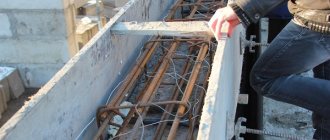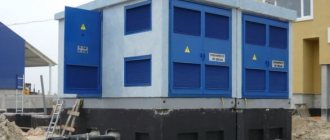Of all the methods of heating concrete, electric is considered the most effective; it ensures uniform temperature distribution throughout the thickness of the poured structure and the correct occurrence of cement hydration processes. The essence of the method is to connect the power supply to a heating wire placed with a regulated step inside, when processing large volumes - three-phase, through transformer substations. The performance and cost of equipment is determined by its rated power; the main manufacturer is Russia.
Device Description
The standard circuit includes an active part (a steel magnetic core with two voltage windings), a shell (a metal cabinet with leads for connecting a three-phase network and output terminals), and a control panel. The cooling system can be different: natural or forced (fan type or using oil). Almost all stations are capable of changing the output power on the LV winding, which in turn allows you to regulate the heating temperature of the connected cable (PNSV, less often PTPG) and save energy consumption during sudden warming. The greater the number of voltage stages, the more versatile and efficient the power device is.
Protection plays an important role: each transformer for heating the concrete is equipped with an automatic switch that responds to short circuits, breaks or changes in input voltage. With modern models, all processes are controlled and reflected: from the presence and condition of the supply network to the parameters at the output of the LV winding. To connect to the main cable (PNSV), an intermediate cable is used; for these purposes, you need to buy an aluminum APV wire. It is impossible to ignore this condition and leave steel cores open, this leads to their rapid burnout. The neutral wire and the housing are grounded.
Power stations are connected to a 380 V network with a frequency of 50 Hz through an appropriate cable; the further the transformer is located from the power supply, the thicker it should be. The change in current strength to the required value occurs due to the phenomenon of electromagnetic induction. The output terminals are connected to a heating cable already immersed in concrete, the device works for the first two hours to warm up, then for 3-4 days in continuous mode. The operating principle is based on the conversion of electrical energy into thermal energy.
Induction heating
Used with reinforced structures. The metal elements contained within them will become cores. The insulated cable acts as an inductor and is placed in loops around the fittings. The number of coils of wire and the cross-section must be calculated in advance. An alternating current is sent along the cable, forming an electromagnetic field. Then the reinforcing elements are heated, from them the heat passes to the concrete, gradually spreading throughout the mixture.
Electricity consumption reaches 150 kW/h per 1 cubic meter of concrete.
Pros: low price; uniform heating.
Cons: complicated calculation; limited application (beams, columns, etc.).
Send a request
Infrared heating
Infrared rays heat the surface of opaque objects, spreading heat throughout the entire volume. When using infrared heating, the concrete structure must be wrapped in a transparent film - it will retain heat by transmitting the rays through itself. Suitable for heating reinforced concrete.
Pros: simplicity and accessibility.
Cons: only suitable for small, thin structures; Infrared heat is distributed unevenly.
The infrared heater must be resistant to strong winds and capable of operating for a long time without refueling.
Conclusions:
- Electrode heating is suitable for a solution of any thickness and shape, but requires high energy consumption (about 1000 kW per 3–5 cubic meters).
- The contact method requires custom-made formwork and cannot provide uniform heating.
- The induction method is applicable exclusively with reinforced structures.
- Infrared heat can only heat a small layer of concrete.
The PNSV wire heats the mixture evenly and is safe to use: the cable is insulated, the temperature is easily regulated.
Our online store also offers diesel stations for heating concrete. You can find out how much the equipment costs taking into account the discount from our managers. Delivery costs depend on the dimensions and weight of the goods.
Equipment
The most common transformer station is KTPTO-80.
To implement electric heating, special equipment is required. In addition to heating wires or electrodes, you will need a power source with specified output current and voltage parameters.
The most common type of such equipment is the KTPTO-80 station on the TMTO-80/0.38 U-3 power transformer. This is an oil-cooled power step-down transformer with a three-filament three-phase winding with a power of 80 kW.
Control panel of the concrete heating station.
Output voltage (LV) is 42 V, input voltage (HV) is 380 V. Supply current frequency is 50 Hz, a three-phase power supply with a rated power of 2.5 kVA is required. The open circuit voltage levels available on the MV side are 55 V, 65 V, 75 V, 85 V and 95 V.
The power of the power transformer winding on the LV side is 2.5 kVA, the current on the MV side at a voltage of 55 - 65 V is 520 A, at a voltage of 75 - 85 - 95 V - 471 A.
In automatic mode, it is possible to adjust the electric heating temperature within the range of 20 - 100 degrees Celsius. A power of 80 kW allows you to heat up to 90 m3 of concrete.
The wire is laid and fixed on the reinforcement frame.
The station is equipped with a power transformer in a casing, a protective housing with doors that facilitate inspection and repair of units, a control unit and protection against emergency modes, brackets, slides or a frame for transporting equipment. The weight of the transformer is 665 kg, dimensions - 147x140x101 mm.
The price of equipment ranges from 90 to 120 thousand rubles, rent is about 10% of the cost per day. Connecting the station and putting it into operation with a load is carried out by a professional power engineer; it is not advisable to do this yourself; moreover, it is prohibited by building regulations and safety regulations. The power engineer must have a standard tolerance of 1000 V.
A modern version of lightweight equipment.
Important! The station can be used as a power source for 42 V power tools and for object lighting. Cutting reinforced concrete with diamond wheels and diamond drilling of holes in concrete at this voltage is not carried out.
TMO-80 for heating concrete
TMO-80 is an oil transformer for heating concrete with a power of 80 kVA. The abbreviation “TMO” stands for:
- "T" - transformer
- "M" - oil
- "O" - for heating
Typically, the TMO transformer is already included in concrete heating stations, such as KTPTO-80, and is not supplied separately. It consists of a three-strand three-phase winding and an oil cooling system that uses special low-viscosity oil.
Technical characteristics of TMO-80:
Voltage value in HV
No-load voltage in CH
55, 65, 75, 85, 95V
Value in low stage of transformer
At U=55-65V it is equal to 520 A; At U=75-95 V it is equal to 471 A.
| Transformer for heating concrete TMO-80 | Price on request | To order | Order |
Concrete mortar gains strength only at positive temperatures. This is due to the fact that water expands under the influence of low temperatures and turns into ice crystals, which break the internal bonds of the solution and completely deprive it of its strength. That is why many builders try to complete all work on the construction of load-bearing concrete structures in the summer or at least in the fall (at positive air temperatures).
However, very often construction companies are under tight deadlines for the delivery of projects and are forced to work even in winter; in this case, the poured concrete must be heated.
Concrete needs to be heated immediately as soon as the air temperature outside the window drops below +5 degrees. At this point, builders carrying out concrete work should become familiar with possible methods of heating concrete. One of these methods is the technology of heating concrete with special transformers.
Without the help of a heating transformer, it is simply impossible to heat concrete using the electrode method and the heating method using PNSV wire. Let's tell you more about each:
Electrode method
Warm-up method using PNSV wire
The electrode method is mainly used when pouring vertical concrete structures.
Station structure
A typical transformer for heating concrete is a mobile single-case installation equipped with a ventilation system. This unit helps convert electrical energy from the network into electricity, which is necessary for the thermal treatment of the concrete mass.
The concrete heating unit includes an active part, which is a rod-type magnetic circuit with two types of winding: LV and HV, yoke beams and low voltage taps.
The installation is also equipped with an automatic switch, which helps prevent possible overloads and power surges, a control panel and a casing with LV terminals.
In addition, heating transformers are equipped with signal lamps installed in the control circuits.
If we talk about choosing a model, there are many substations on the market today. However, according to technical regulations, it is recommended to carry out work using a concrete heating station KTPTO 80 or SPB-20.
Why do you need a technological map for heating concrete?
Most of Russia's territory is a region with distinct seasons. There is a winter with negative temperatures, a warm summer and an off-season.
When carrying out private development, builders plan concrete work for the beginning of autumn, but in large construction it is unprofitable to allow downtime in work for six months. There may be other reasons for concreting at inappropriate temperatures:
- Work on soft soils, which are only possible in winter.
- Seasonal reduction in the cost of materials and work.
- The ability to transport materials on frozen roads without any problems.
Therefore, measures have been developed to warm up the concrete.
Why is it necessary to warm up concrete in winter?
SP 70.13330 states that concreting work at average daily outside air temperatures below +5° C or at a minimum daily air temperature below 0° C is considered winter concreting.
Why do these temperatures stand out?
The main component of concrete is cement. It is also called astringent.
Cement is a water-hardening binder. This means that in order to obtain a hard and durable concrete stone, it is necessary for the cement components to enter into chemical reactions with water, the so-called hydration reactions.
From the outside it seems that the cement was simply mixed with water and aggregates and dried, but this is not so. When cement components, such as alit, belite, tricalcium aluminate and tetracalcium aluminoferrite, react, new compounds with a crystalline structure are formed.
Hydration processes take time; allite, ferrite and aluminate phases react quickly, belite reacts more slowly. A total of 28 days are needed for the concrete to reach its design strength.
The critical strength of concrete is also distinguished. This is strength, upon reaching which concrete is no longer afraid of unfavorable environmental conditions; usually this is 30-50% of the design strength.
The optimal conditions for concrete hardening are:
- outside air temperature 18-20° C;
- high air humidity.
What happens if the air temperature drops below?
As the temperature decreases, chemical reaction processes slow down more and more.
Subsequently, if the concrete is heated, it will gain strength, but it will be lower than expected.
If the air temperature drops to 0° C or lower, the water that has not had time to react with the cement components will freeze. When it freezes, it will expand and lead to the formation of voids and cracks in the concrete, which will negatively affect the strength of the finished product. The formation of an ice film around the reinforcement will contribute to its peeling.
Since the amount of water in the concrete mixture is calculated in advance, the cement components will not have enough water to react, thus hydration will not take place completely, and this will reduce the strength of the concrete.
That is why, when concreting in winter, certain measures should be taken to ensure the correct occurrence of hydration reactions.
These measures are divided into three types:
- adding special components to the concrete solution;
- heat preservation;
- heating the concrete.
Each of these activities has its pros and cons. The decision is made based on the specific situation.
There are certain standards for carrying out any warming activities that allow them to be carried out most efficiently and economically. They are reflected in technological maps.
The use of special additives for concrete solutions.
Antifreeze additives increase the rate of reactions and at the same time reduce the pour point of water in the mixture, due to which concrete hardens even at low temperatures.
Hardening accelerator additives contribute to the rapid development of critical strength, after which the concrete is no longer afraid of the cold.
The simplest option for antifreeze additives is chloride salts, but their use has many limitations, since they are not compatible with any type of Portland cement and only work up to a temperature of –10°C; in addition, they are not recommended for use in reinforced structures, since they can cause corrosion fittings.
Another thing is special additives, for example, CemFrio and HotIce from CEMMIX.
These supplements have many benefits:
- low dosages;
- simple adding procedure;
- efficient operation down to a temperature of –20° C without warming up;
- additional plasticizing effect, allowing to obtain mixtures with increased workability;
- preventing mixture separation;
- good compatibility with all types of cements and reinforcement;
- saving cement and water;
- increasing the strength of the finished product.
Heat preservation
When hydration reactions occur in the concrete mixture, heat is released. If the poured structure is large and thick enough, enough heat is generated to prevent the concrete from freezing. You just need to save it.
For this purpose, the thermos method is used:
- Concrete is mixed from heated materials. Cement cannot be heated to avoid “cooking”, but aggregates, reinforcement and formwork are heated with hot air, water is heated to a temperature of 70° C.
- Insulated formwork is used.
- After laying the concrete mixture, its temperature should not be lower than +10° C.
- The filling is covered with heat-insulating materials. Sometimes special heating mats are used.
- Peripheral parts of structures can be additionally heated by electrodes.
- Additionally, antifreeze additives are used for concrete.
The thermos method is effective for large structures, but it is not enough if the pour has a large cooling area or the temperatures are too low (below -10° C).
Warming up the concrete
There are several ways to heat concrete:
- warm houses;
- electrode heating;
- infrared heating;
- induction heating;
- thermomats;
- heating of concrete using PNSV.
Teplyaki
Teplyaks are a kind of “tents” that are erected over a concrete pour. Heat guns are installed inside to maintain the temperature at the desired level. Once the structure reaches critical strength, the tents can be dismantled.
Electrode heating
Electrodes are fixed inside the formwork, so that current can be passed through the concrete solution and thus heat the concrete.
The technological map for electrode heating of monolithic concrete structures contains organizational and technical solutions for electrode heating of concrete in order to speed up work and improve the quality of structures that are manufactured in the cold season.
These solutions are developed in accordance with the requirements of SNiP. You can find out more about them in SP 70.13330.2012 “Load-bearing and enclosing structures”, clause 5.11 “Concrete work at sub-zero temperatures”.
- scope of application of electrode heating (through, peripheral, reinforcing) with diagrams and instructions on the preparation of structures;
- admissibility of the use of antifreeze additives, their type and quantity;
- scope of application of hydrothermal insulation;
- methods and work schedule;
- labor cost calculation;
- warm-up parameters;
- necessary material and technical resources;
- safety precautions;
- requirements for quality and acceptance of work;
- technical and economic indicators.
The technological map allows you to correctly and timely carry out all the necessary work on electrode heating of concrete structures in winter.
Infrared heating
Concrete is heated with infrared radiation.
Induction heating
It warms up the reinforcement, which also warms up the concrete.
Thermomat
Heaters are laid out in the form of mats on the pouring surface. They heat the concrete evenly.
Heating concrete using PNSV (heating wire with a steel core and insulation made of polyethylene or polyvinyl chloride plastic)
The PNVS wire is deciphered as follows:
- P - wire;
- H - heating;
- C - wire material (steel);
- B - insulation material (vinyl, which is more correctly called polyvinyl chloride).
The wire is immersed in concrete; Check the voltage in the circuit at least twice per shift.
The technological map for electrical heating of monolithic structures with heating wires contains instructions for electrical heating of structures using PNSV. In it you can find information regarding the scope of application of the method, organization and technology of work, and acceptance requirements.
Review of common transformer models
The modern construction market is represented by a wide variety of models of transformer stations for heating foundations. But when performing these types of work, it is recommended to use devices that are most suitable according to the technical regulations.
The main criteria for choosing an installation:
- Internal equipment of the transformer;
- According to the power level of the unit and the presence of a different number of voltage levels;
- Type of cooling of current-carrying wires and transformer elements (models with natural (dry) cooling, oil and forced).
Below is a list of the most popular models of transformer stations that best meet the presented requirements.
KTPTO 80-86
The transformer installation has three operating phases, power is 80 kW and power supply is 380V. Scope of application: heating of foundations. An internal oil cooling system for conductive elements is installed. Fully automated workflow. Recommended operating temperature ranges from -40 to +10 degrees. The optimal working area is up to 40 m3.
The main advantages of the KTPTO 80-86 transformer:
- Simple design equipment of the installation;
- The presence of external terminals necessary for connecting other devices to the circuit.
The main disadvantages of the KTPTO 80-86 transformer:
- Large installation, causes some difficulties during transportation;
- The weight of the unit is quite large; movement is possible with the use of additional structural elements or third-party force;
- The unit requires frequent maintenance (every three months).
The transformer unit is manufactured in several different versions, some models have additional equipment. Modified stations have less weight and dimensions. Design features are distinguished by the presence of manual and automatic process control modes. The price range is 125,000 – 180,000 thousand rubles.
SPB-20
Three-phase transformer with a minimum set of functionality, with a power level of 20 kW. The scope of application is limited due to low power, suitable for minor construction work and the construction of small buildings. There is a natural (dry) cooling system. Recommended operating temperature ranges from -40 to +5 degrees. The optimal working area is up to 20 m3.
The main advantages of the SPB-20 transformer:
- Small dimensions and wheelbase for easy transportation;
- Characterized by increased reliability and protection from power surges.
The main disadvantages of the SPB-20 transformer:
- Fragile switching and adjustment components.
This model of transformer installation is presented in several versions. Modified stations have less or more power. The price range is 20,000 – 160,000 thousand rubles.
TSDZ-63/0.38
The transformer has three operating phases, with a power level of 63 kW. There is a forced cooling system. Recommended operating temperature ranges from -40 to +20 degrees. The installation operates uninterruptedly. Excellent for construction work on medium-sized buildings and structures.
The main advantages of the TSDZ-63/0.38 transformer:
- Small dimensions and weight;
- Equipped with an automatic switch.
The main disadvantages of the TSDZ-63/0.38 transformer:
- Frequent failure of the cooling system.
The price range is 61,000 – 79,000 thousand rubles.
TSDZ-80/0.38 UZ
This station is similar to the previous transformer installation. Except for some items. It is a modified analogue with expanded design equipment.
The main advantages of the transformer TSDZ-80/0.38 UZ:
- Small dimensions and weight;
- The operating mode is fully automated.
- Increased level of protection.
The main disadvantages of the TSDZ-80/0.38 UZ transformer:
- If it breaks down, further restoration and repair is impossible.
The price range is 70,000 – 100,000 thousand rubles.
How long does it take to warm up concrete?
The concrete is heated until it reaches critical strength (30-50% of the design strength). This usually happens on the 4th-6th day.
The strength of concrete is determined by the actual temperature conditions using graphs.
To more accurately determine the timing, laboratory tests are used, for which sample castings are made and allowed to gain strength under the same conditions as the main structure.
The use of anti-frost additives during winter concrete work guarantees the production of high-quality concrete structures even in conditions of negative temperatures. Combining the use of antifreeze additives with the thermos method or heating the concrete not only guarantees strength gain, but also reduces the duration of heat treatment, which means it saves energy and increases the turnover of expensive equipment and formwork. Proper use of warming measures and anti-frost additives in accordance with the technological map allows us to obtain high-quality winter concrete.
Warming up concrete with PNSV heating wire
Pouring concrete in winter has its own difficulties. The main problem is the normal hardening of the solution, the water in which can freeze and it will not gain technological strength. Even if this does not happen, the low drying rate of the composition will make the work unprofitable. Warming up the concrete with a PNSV wire will help resolve this issue.
Electric heating of concrete in winter is the most convenient and cheapest way to achieve the desired hardness of the material. It is permitted by the standards of SP 70.13330.2012, and can be used when performing any construction work. After the concrete hardens, the wire remains inside the structure, so the use of cheap PNSV provides an additional economic effect.
- Application
- Wire characteristics
- Heating technology and laying scheme
- Length calculation
Warm-up methods
There are two main ways to heat concrete using electric current in a transformer specially designed for this purpose. One of these methods involves the use of PNSV wires, while the other method uses electrodes. When heating the poured hardening concrete solution, it is necessary to insulate, or better yet, thermally insulate the heated volume. Otherwise, the concrete will warm up differently in different places. And this, in turn, will lead to a decrease in the strength of the finished concrete structure.
Application
Warming up concrete in winter with a cable makes it possible to solve two main problems. At temperatures below zero, the water in the solution turns into ice crystals, and as a result, the cement hydration reaction not only slows down, it stops completely. It is known that when water freezes, it expands, destroying the bonds formed in the solution, so after increasing the temperature it will no longer gain the required strength.
The solution hardens at optimal speed and maintains characteristics at a temperature of about 20°C. As temperatures drop, especially below freezing, these processes slow down, even though hydration produces additional heat. In order to meet technical conditions, in winter it is impossible to do without heating the concrete with a PNSV wire or another cable intended for this purpose in situations where:
- sufficient thermal insulation of the monolith and formwork is not provided;
- the monolith is too massive, which makes it difficult to heat it evenly;
- low ambient temperature at which water in solution freezes.
Functional Features
The climatic conditions in our country are particularly harsh, so builders often have to work in freezing temperatures. It is precisely for those cases when it is urgently necessary to build a concrete structure, but the air temperature outside does not rise above zero, special devices have been created, the main task of which is to provide the very conditions necessary for the normal hardening of concrete.
How the device works
A transformer for heating concrete runs on electricity . Such devices are widely used by builders, as a result of which the construction of various concrete structures is significantly accelerated and simplified, especially in the cold season.
After preparation, the concrete mixture is heated by electricity, and the concrete itself, being connected to the electrical network, plays the role of a conductor. In this case, the energy is converted from electrical into thermal. This can occur directly in the cement mixture or on its surface. It all depends on the type of wires and electrodes used.
Using a transformer, concrete can be heated to a certain temperature in a certain period of time. The main thing is to choose the right current power. Those who use such equipment, of course, have the opportunity to choose one of several heating modes, which also increases productivity and makes work more efficient.
Such a transformer is suitable for heating a large volume of concrete mixture. If you need to build some small structure from concrete, then the use of this equipment is considered inappropriate.
With high current power, the concrete mixture can heat up to a temperature of more than 80 degrees, and the heating rate can be adjusted by the builder at his discretion. If you increase the current power, it will only take a few minutes to heat up. If, on the contrary, you reduce the power, the process will last longer.
Wire characteristics
The cable for heating concrete PNSV consists of a steel core with a cross-section from 0.6 to 4 mm², and a diameter from 1.2 mm to 3 mm. Some types are galvanized to reduce the impact of aggressive components in mortars. Additionally, it is covered with heat-resistant polyvinyl chloride (PVC) or polyester insulation; it is not afraid of kinks, abrasion, aggressive environments, is durable and has high resistivity. The PNSV cable has the following technical characteristics:
- The resistivity is 0.15 Ohm/m;
- Stable operation in the temperature range from -60°C to +50°C;
- Up to 60 m of wire is consumed per 1 cubic meter of concrete;
- Can be used at temperatures down to -25°C;
- Installation at temperatures down to -15°C.
The cable is connected to the cold ends through an aluminum autorecloser wire. Power can be supplied via a three-phase 380 V network by connecting to a transformer. With proper calculation, the PNSV can also be connected to a 220-volt household network; the length should not be less than 120 m. An operating current of 14-16 A should flow through the system located in the concrete mass.
Criterias of choice
When choosing a transformer for heating concrete, it is necessary to take into account the size of the structure being built. In addition, the degree of insulation and ambient temperature are of considerable importance. For example, if construction work is planned to be carried out during not very cold weather, then you can use a less powerful, and, therefore, cheaper device.
When choosing a transformer, first of all you should pay attention to its power . After all, the time it will take to complete a certain amount of work depends on this characteristic.
If the need to heat concrete occurs quite rarely (for example, no more than once a year), it is more profitable not to buy a transformer station, but to rent it. In this case, you can not only save a lot of money, but also select the required power, as well as determine other technical parameters of the device for the implementation of a specific construction project. You can rent the equipment for a day by paying a certain amount for it (usually about $15). Of course, you can rent a device for a longer period of time, but then the total cost will increase.
Before buying or renting a heating transformer for concrete, you need to find out how it can perform heating: using electrodes or using PNSV wires.
Transformer TSDZ-63
This device has 3 different low voltage settings . It must be connected to a network with a voltage of 380 V and a frequency of 50 Hz. It can work without interruption for quite a long time both at 45 degrees below zero and at temperatures of plus 20 degrees.
The advantages of this transformer station also include its light weight and small size. The machine prevents failure due to sudden voltage surges and short circuits in the network. Before connecting the unit to the network, it is necessary to ground it.
Model KTPTO-80
This design is an oil-immersed 3-phase transformer. It has 5 voltage switching stages (minimum - 55 V, maximum - 95 V). The equipment can be connected to a network with a voltage of 380 V and 42 V.
The KTPTO-80 station is widely used by construction organizations . Its main advantages include reliability, low price and high quality of work.
Transformers for heating concrete have helped many people build strong and durable concrete structures during the harsh winter. After all, if in a slight frost of just minus 5 or minus 10 degrees, special components added to the mixture can still help out, then when the thermometer drops below 25 degrees, the only thing you can rely on is the transformer station.
Heating technology and laying scheme
Before installing the concrete heating system in winter, formwork and reinforcement are installed. After this, the PNSV is laid out with an interval between the wires of 8 to 20 cm, depending on the outside temperature, wind and humidity. The wire is not stretched and is attached to the fittings with special clamps. Bends with a radius of less than 25 cm and overlaps of current-carrying conductors should not be allowed. The minimum distance between them should be 1.5 cm, this will help prevent short circuits.
The most popular installation scheme for PNSV is a “snake”, reminiscent of a “warm floor” system. It provides heating of the maximum volume of concrete mass while saving heating cable. Before pouring the solution into the formwork, you must make sure that there is no ice in it, the temperature of the mixture is not lower than +5°C, and the installation of the connection diagram is carried out correctly, and the cold ends are brought out to a sufficient length.
The PNSV wire comes with instructions, which you need to read before heating the concrete. The connection is made through sections of busbars in two ways through a “triangle” or “star” circuit. In the first case, the system is divided into three parallel sections connected to the terminals of a three-phase step-down transformer. In the second, three identical wires are connected into one node, then three free contacts are similarly connected to the transformer. The power supply is installed no further than 25 m from the connection point, the heated area is surrounded by a fence. The system is connected after the entire volume of mortar has been completely filled. The technology for heating concrete with a PNSV heating cable includes several stages:
- Heating is carried out at a rate of no more than 10°C per hour, which ensures uniform heating of the entire volume.
- Heating at a constant temperature continues until the concrete reaches half its technological strength. The temperature should not exceed 80°C, the optimum is 60°C.
- Cooling of the concrete should occur at a rate of 5°C per hour, this will help avoid cracking of the mass and ensure its solidity.
If the technological requirements are met, the material will gain a grade of strength corresponding to its composition. At the end of the work, the PNSV remains in the thickness of the concrete and serves as an additional reinforcing element.
It should be noted that using a KDBS or VET cable is much easier, since they can be connected directly to a 220 V network through a panel or socket. They are divided into sections, which helps to avoid overload. But these cables are more expensive than PNSV, so they are less often used in the construction of large facilities.
Another popular technology is the use of formwork with heating elements and electrodes, when the reinforcement is inserted into the solution and connected to the network using a welding machine or another type of step-down transformer. This heating method does not require a special heating cable, but is more energy-consuming, since water in concrete acts as a conductor, and its resistance increases significantly during hardening.
Feasibility of application
The need for such equipment arises when pouring in winter: the main requirement for proper hydration of cement-based mortars is their hardening at normal or high humidity and temperatures above 0°. Hardening under other conditions leads to deterioration of the concrete structure, the formation of cracks and a sharp decrease in its strength. To solve this problem, different methods are used: installing thermal guns, introducing specialized admixtures into the composition, covering poured structures, external heating, but none of them provides such uniformity as electric heating.
It is not necessary to use a step-down transformer to warm up frozen soil and concrete; two-core cable sections, for example, are connected directly to the network. But a “star” or “triangle” connection provides more economical energy consumption and is optimal when placed in the thickness of a single-core wire. This design is chosen primarily when working with large volumes; one device processes from 10 to 100 m3. To achieve uniform heating, a number of conditions are met: the temperature of the poured solution cannot be lower than +5 °C, the cable is laid at intervals of 15 cm horizontally and 20 cm vertically, the process is maintained continuously.
Despite the significant investment in equipment and the inability to reuse the cable, the technology is considered cost-effective and reliable.
Length calculation
To calculate the length of the PNSV wire for heating concrete, several main factors must be taken into account. The main criterion is the amount of heat supplied to the monolith for its normal hardening. It depends on the ambient temperature, humidity, the presence of thermal insulation, volume and shape of the structure.
Depending on the temperature, the cable laying pitch is determined with an average loop length of 28 to 36 m. At temperatures down to -5°C, the distance between the cores or pitch is 20 cm, with a decrease in temperature for every 5 degrees, it decreases by 4 cm, at - At 15°C it is 12 cm.
When calculating the length, it is important to know the power consumption of the PNSV heating wire. For the most popular diameter of 1.2 mm, it is equal to 0.15 Ohm/m; for wires with a large cross-section, the resistance below a diameter of 2 mm has a resistance of 0.044 Ohm/m, and 3 mm – 0.02 Ohm/m. The operating current in the core should be no more than 16 A, therefore the power consumption of one meter of PNSV with a diameter of 1.2 mm is equal to the square of the current and the resistivity and is 38.4 W. To calculate the total power, you need to multiply this figure by the length of the laid wire.
The voltage of the step-down transformer is calculated in a similar way. If 100 m of PNSV with a diameter of 1.2 mm are laid, then its total resistance will be 15 Ohms. Considering that the current is no more than 16 A, we find the operating voltage equal to the product of the current and the resistance; in this case it will be equal to 240 V.
The use of PNSV wire is one of the cheapest ways to heat concrete. But it is more suitable for use by professional builders, since its connection requires special knowledge and equipment. This cable can also be used at home if you correctly calculate the power consumption. The use of thermal insulation materials will help reduce costs when heating the solution; in this case, heating will occur faster, and the temperature decrease will occur more evenly, which will improve the quality of concrete.
The principle of heating by contact method
The technology of such heating is that the concrete is heated to the required temperature thanks to conductive wires PNSV with a cross-section of 1.2 mm, which are laid on the reinforcing frame before filling the formwork with a cement-sand mixture. After this, a concrete mass is laid, which is compacted, covered with insulation (for example, roofing felt) and covered with sawdust. After this, the heating cable is connected to the transformer (substation) and the time is set during which the liquid solution will be heated to 80 degrees.
As a rule, a step-down transformer station has several voltage levels, thanks to which it is possible to regulate the level of heat created in the solution (depending on changes in ambient temperature).
One concrete heating station is enough to retain heat over an area of up to 80 m3.
Take a closer look at what these substations are.











